Abstract
Cefoxitin was administered intravenously to 143 patients, 67% of whom were seriously ill. The rate of cure or improvement was 93%. The study was conducted in two phases; the first was an open, controlled clinical comparison of cefoxitin and cephalothin. In this phase, 28 patients received cefoxitin and 29 received cephalothin. In the second phase, cefoxitin alone was used for the treatment of an additional 115 patients. Twenty bacteremic patients treated with cefoxitin were cured or improved in 95% of cases. The infecting organism was eradicated in all bacteremic patients. All of 14 anaerobic or predominantly anaerobic infections were cured or improved. The infecting anaerobic organism was eliminated in 86% of the cases. Twenty-five patients infected by cephalothin-resistant, cefoxitin-susceptible gram-negative rods were cured. Three patients each with infective endocarditis and osteomyelitis were cured. The incidence of adverse experiences was: 1.4% drug eruption; 2% each asymptomatic serum transaminase elevation and leukopenia; and 2.5% asymptomatic eosinophilia. The incidence of severe thrombophlebitis was 5%. No permanent or serious adverse reactions were encountered. Although the numbers of patients in some categories were too small to permit statistical evaluation, I feel that cefoxitin may be a useful new antibiotic for treatment of infections caused by cehalothin-resistant bacteria and by anaerobic organisms.
Full text
PDF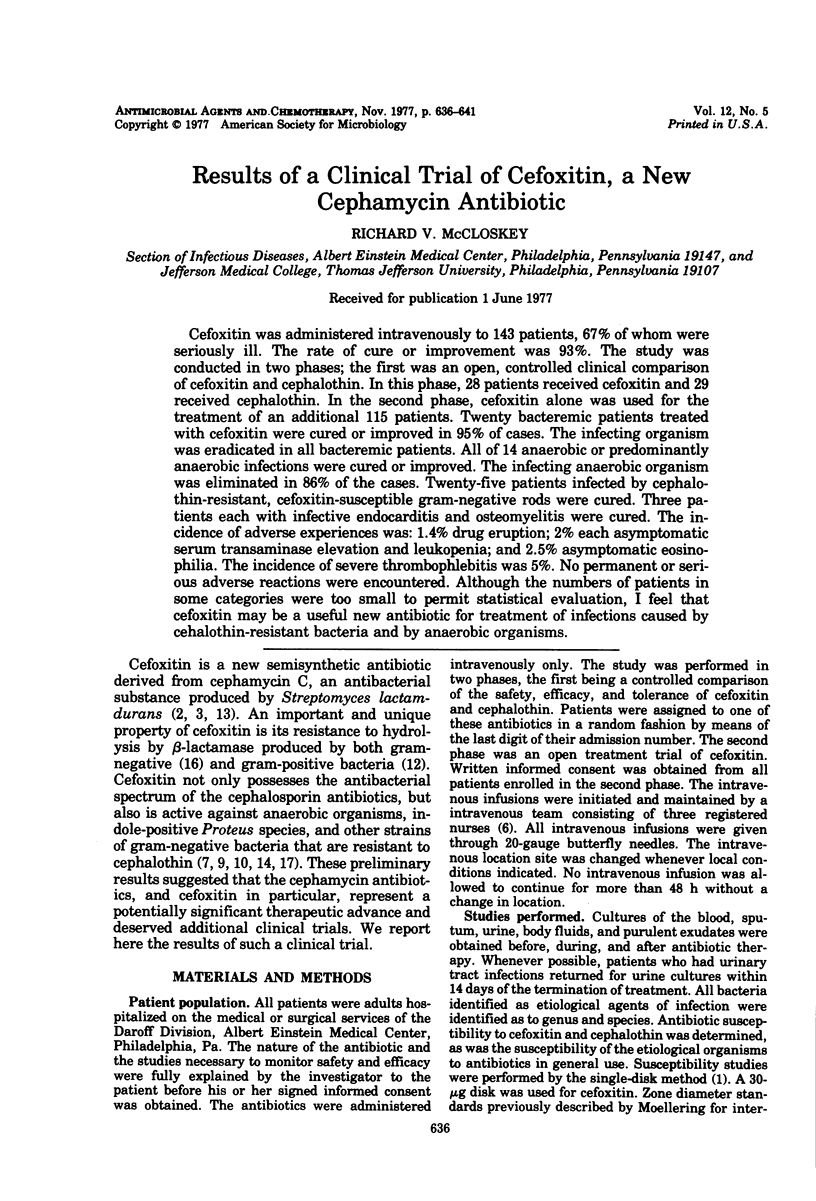
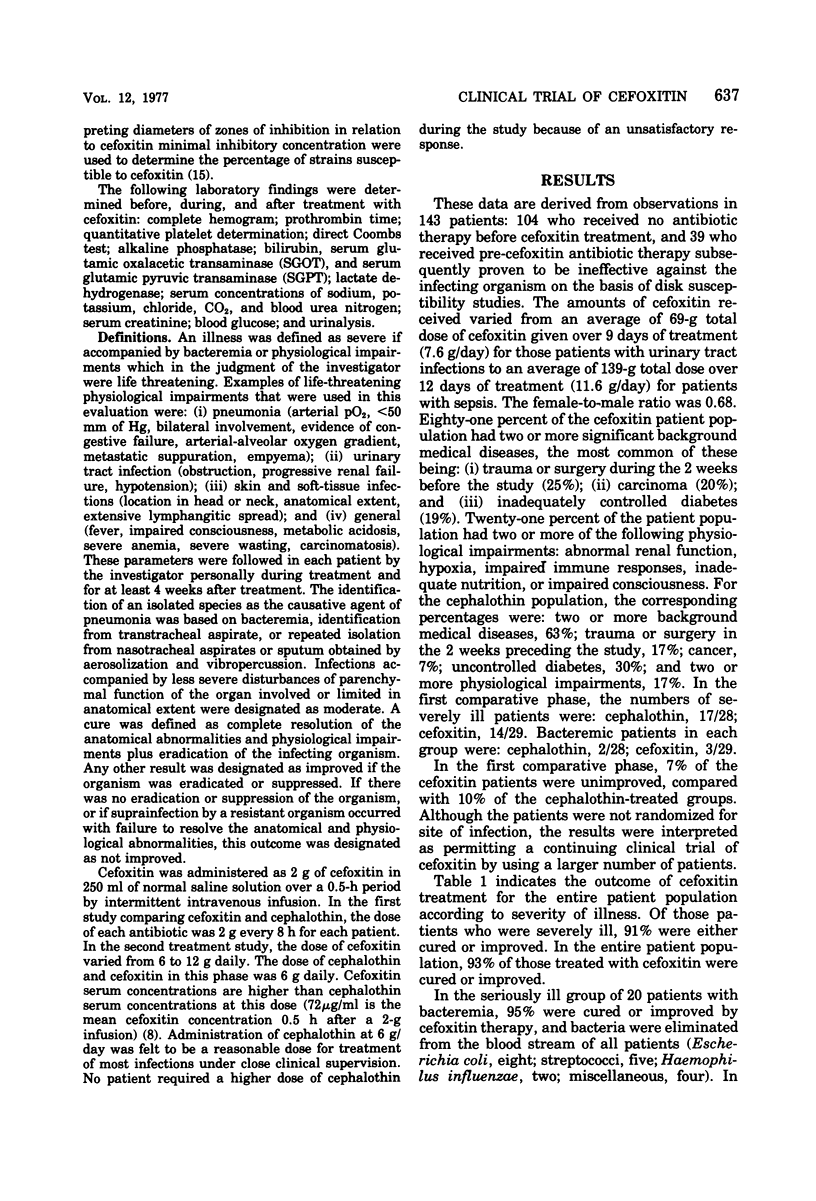
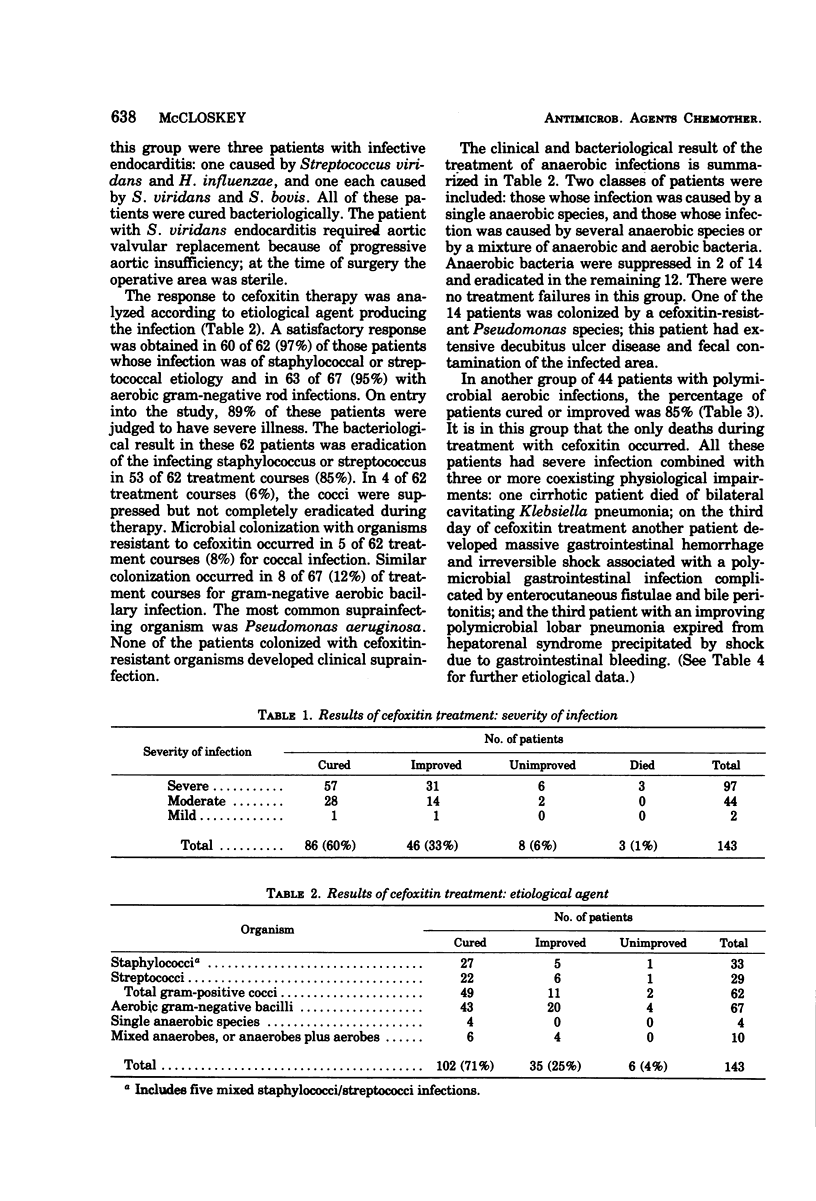
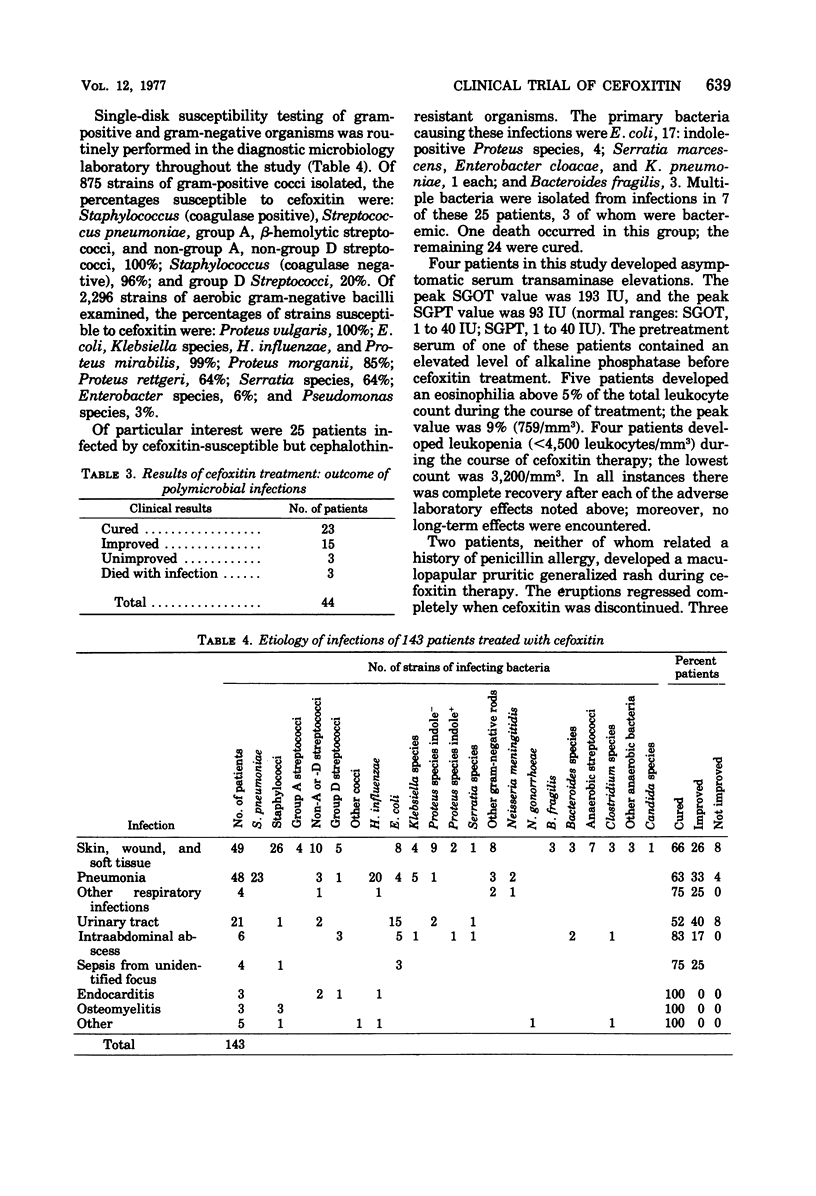
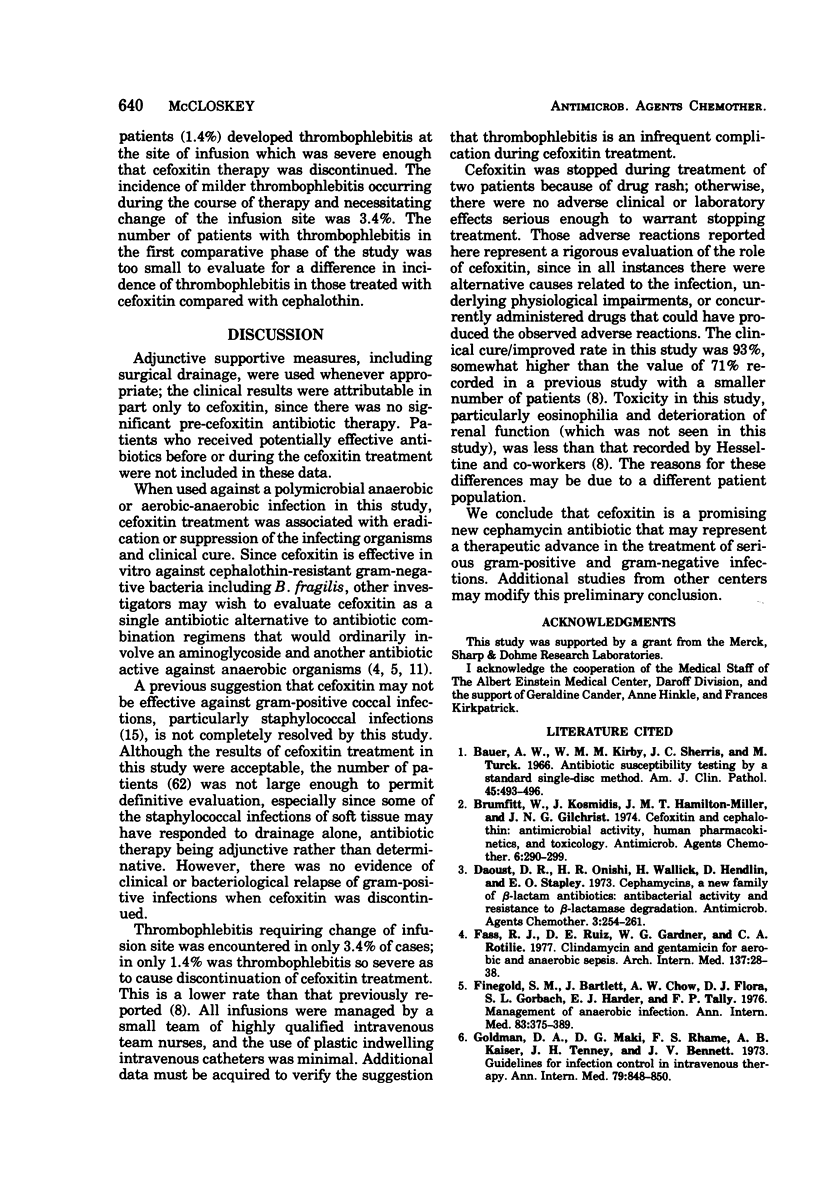
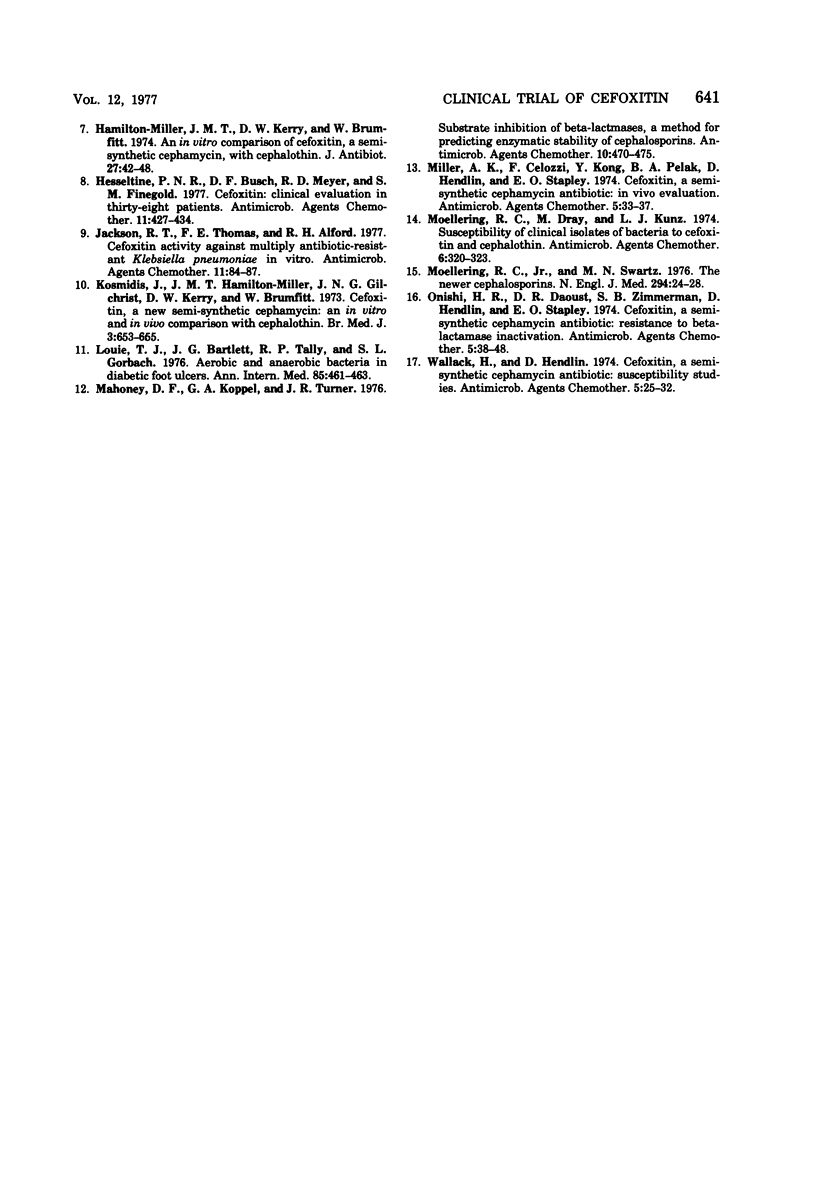
Selected References
These references are in PubMed. This may not be the complete list of references from this article.
- Bauer A. W., Kirby W. M., Sherris J. C., Turck M. Antibiotic susceptibility testing by a standardized single disk method. Am J Clin Pathol. 1966 Apr;45(4):493–496. [PubMed] [Google Scholar]
- Brumfitt W., Kosmidis J., Hamilton-Miller J. M., Gilchrist J. N. Cefoxitin and cephalothin: antimicrobial activity, human pharmacokinetics, and toxicology. Antimicrob Agents Chemother. 1974 Sep;6(3):290–299. doi: 10.1128/aac.6.3.290. [DOI] [PMC free article] [PubMed] [Google Scholar]
- Daoust D. R., Onishi H. R., Wallick H., Hendlin D., Stapley E. O. Cephamycins, a new family of beta-lactam antibiotics: antibacterial activity and resistance to beta-lactamase degradation. Antimicrob Agents Chemother. 1973 Feb;3(2):254–261. doi: 10.1128/aac.3.2.254. [DOI] [PMC free article] [PubMed] [Google Scholar]
- Fass R. J., Ruiz D. E., Gardner W. G., Rotilie C. A. Clindamycin and gentamicin for aerobic and anaerobic sepsis. Arch Intern Med. 1977 Jan;137(1):28–38. [PubMed] [Google Scholar]
- Finegold S. M., Bartlett J. G., Chow A. W., Flora D. J., Gorbach S. L., Harder E. J., Tally F. P. Management of anaerobic infections. Ann Intern Med. 1975 Sep;83(3):375–389. doi: 10.7326/0003-4819-83-3-375. [DOI] [PubMed] [Google Scholar]
- Goldman D. A., Maki D. G., Rhame F. S., Kaiser A. B., Tenney J. H., Bennett J. V. Guidelines for infection control in intravenous therapy. Ann Intern Med. 1973 Dec;79(6):848–850. doi: 10.7326/0003-4819-79-6-848. [DOI] [PubMed] [Google Scholar]
- Hamilton-Miller J. M., Kerry D. W., Brumfitt W. An in vivo comparison of cefoxitin, a semi-synthetic cephamycin, with cephalothin. J Antibiot (Tokyo) 1974 Jan;27(1):42–48. doi: 10.7164/antibiotics.27.42. [DOI] [PubMed] [Google Scholar]
- Heseltine P. N., Busch D. F., Meyer R. D., Finegold S. M. Cefoxitin: clinical evaluation in thirty-eight patients. Antimicrob Agents Chemother. 1977 Mar;11(3):427–434. doi: 10.1128/aac.11.3.427. [DOI] [PMC free article] [PubMed] [Google Scholar]
- Jackson R. T., Thomas F. E., Alford R. H. Cefoxitin activity against multiply antibiotic-resistance Klebsiella pneumoniae in vitro. Antimicrob Agents Chemother. 1977 Jan;11(1):84–87. doi: 10.1128/aac.11.1.84. [DOI] [PMC free article] [PubMed] [Google Scholar]
- Kosmidis J., Hamilton-Miller J. M., Gilchrist J. N., Kerry D. W., Brumfitt W. Cefoxitin, a new semi-synthetic cephamycin: an in-vitro and in-vivo comparison with cephalothin. Br Med J. 1973 Dec 15;4(5893):653–655. doi: 10.1136/bmj.4.5893.653. [DOI] [PMC free article] [PubMed] [Google Scholar]
- Louie T. J., Bartlett J. G., Tally F. P., Gorbach S. L. Aerobic and anaerobic bacteria in diabetic foot ulcers. Ann Intern Med. 1976 Oct;85(4):461–463. doi: 10.7326/0003-4819-85-4-461. [DOI] [PubMed] [Google Scholar]
- Mahoney D. F., Koppel G. A., Turner J. R. Substrate inhibition of beta-lactamases, a method for predicting enzymatic stability of cephalosporins. Antimicrob Agents Chemother. 1976 Sep;10(3):470–475. doi: 10.1128/aac.10.3.470. [DOI] [PMC free article] [PubMed] [Google Scholar]
- Miller A. K., Celozzi E., Kong Y., Pelak B. A., Hendlin D., Stapley E. O. Cefoxitin, a semisynthetic cephamycin antibiotic: in vivo evaluation. Antimicrob Agents Chemother. 1974 Jan;5(1):33–37. doi: 10.1128/aac.5.1.33. [DOI] [PMC free article] [PubMed] [Google Scholar]
- Moellering R. C., Jr, Dray M., Kunz L. J. Susceptibility of clinical isolates of bacteria to cefoxitin and cephalothin. Antimicrob Agents Chemother. 1974 Sep;6(3):320–323. doi: 10.1128/aac.6.3.320. [DOI] [PMC free article] [PubMed] [Google Scholar]
- Moellering R. C., Jr, Swartz M. N. Drug therapy: The newer cephalosporins. N Engl J Med. 1976 Jan 1;294(1):24–28. doi: 10.1056/NEJM197601012940106. [DOI] [PubMed] [Google Scholar]
- Onishi H. R., Daoust D. R., Zimmerman S. B., Hendlin D., Stapley E. O. Cefoxitin, a semisynthetic cephamycin antibiotic: resistance to beta-lactamase inactivation. Antimicrob Agents Chemother. 1974 Jan;5(1):38–48. doi: 10.1128/aac.5.1.38. [DOI] [PMC free article] [PubMed] [Google Scholar]
- Wallick H., Hendlin D. Cefoxitin, a semisynthetic cephamycin antibiotic: susceptibility studies. Antimicrob Agents Chemother. 1974 Jan;5(1):25–32. doi: 10.1128/aac.5.1.25. [DOI] [PMC free article] [PubMed] [Google Scholar]


